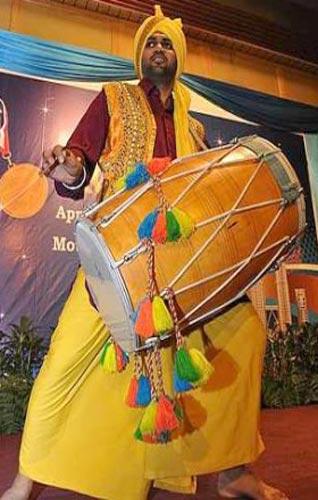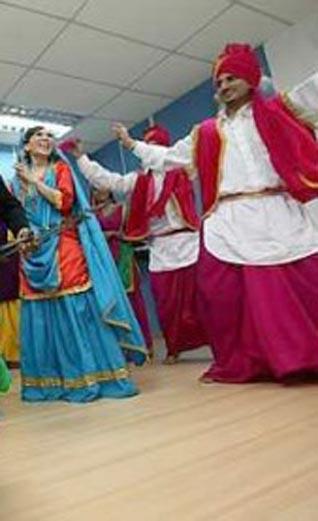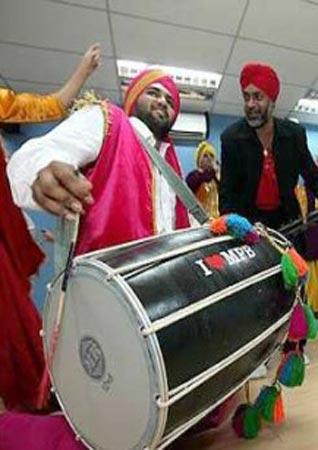Music
Revelling in The Bhangra
by AIDA AHMAD
The beat of the dhol dominates the room as men and women put the finishing touches to their colourful costumes before taking to the dance floor.
This is where Harcharan Singh, 48, is in his element as he shares his skills and knowledge of Bhangra, the exuberant music and dance that's the mainstay of Sikh weddings and is now becoming popular at other occasions.
Dhol, a large, high-bass drum, is the instrument that defines the Bhangra, which Harcharan began to learn at the tender age of 13. Now he is the proud founder and owner of the Malaysian Punjabi Bhangra, which provides event management services and Bhangra dance performances.
"We have been the National Bhangra and Bollywood Dance Troupe since 1978. It's a full time passion for me now," says Harcharan, a former senior sales executive with an international beverage company.
"We started as a Bhangra dance group and performed only at weddings. But now, together with my son, we provide comprehensive services such as offering Bollywood dances as well as production equipment for corporate shows, launchings and parades," he says.
One of Harcharan's fondest memories is of the group performing at the Gloria Estefan and the Miami Sound Machine concert in the mid-80s.
"When Miami Sound Machine performed in Stadium Negara in the 80s, they were at the height of their success. We gave her (Estefan) a surprise when we went on stage to perform the Bhangra dance with the band.
"Surprisingly, Bhangra harmonised really well with their upbeat jazz tempo," he recalls.
"Gloria Estefan loved our performance so much that we even put up another dance for her days later during a pre-dinner show. She was very happy indeed."
Harcharan's Bhangra group is a multi-racial mix of people who revel in the spirit of the folk music and dance tradition that originated in the Punjab region of the sub-continent and was performed to celebrate the coming of the harvest season.
Freelance dancer Maslinda Mansor, 36, has been learning the Bhangra under Harcharan's guidance over the past year.
"In total, I have been doing Bhangra for almost four years. I love it because it is so lively and interesting," says the lass from Parit Buntar, Perak.
"As a dancer, I think it is important to learn dances from different cultures," she adds.
T. Yogeswaran, 24, who is of Indian-Chinese parentage, has been with the group for the past three years. He practises twice a week and looks forward to the sessions. "The music, the moves, everything ... Bhangra is so much fun and energetic," says this electronic engineering student who has loved "anything to do with music and dancing" since he was a child.
But if you think Bhangra is just about gyrating and moving one's limbs to the beat of fast-paced music, think again.
"Some of the dance steps and stunts take a lot of time to master," says civil engineering student Mikhel Chandra, 22, a Malaysian of Gujerati descent. "But I do it because I just love the Bhangra rhythm. There are not many active Bhangra and Bollywood dance groups here, so I was glad to find Harcharan's group."
When he is not spinning as a DJ in a club, Harcharan's son Simranjit, 24, has a full-time job making sure the operations of the Malaysian Punjabi Bhangra troupe proceed smoothly.
He dances as well, and also teaches Bhangra and Bollywood dance at their dancing studios in Klang and Taman Connaught, Cheras.
Sikh parents place a lot of importance on their children having a white collar profession, Simranjit says. "But for me, I've always wanted to be in the entertainment line and luckily my dad is in the same wavelength. I really wish I could sing, though, but I'll stick to dancing," he says with a laugh.
Harcharan's group is not short of Bollywood talents, for sure. One of the instructors, Supriya D'Souza, 26, has actually been a backup dancer for big names like Salman Khan and Arbaaz Khan. D'Souza came to Malaysia after she was invited by Simranjit to join the group. "I have been a dancer since I was seven. It's an enjoyable career to be in and I love teaching people and helping Simranjit with the choreography," she says.
Forms of the Bhangra
The term "Bhangra" now refers to several kinds of dances and arts, including Jhumar, Luddi, Giddha, Julli, Daankara, Dhamal, Saami and Kikli.
Jhumar, originally from Sandalbar, Punjab, is an important part of Punjabi folk heritage. It is a graceful dance, based on a specific rhythm where dancers circle around a drum player while singing a soft chorus.
A person performing the Luddi dance places one hand behind his head and the other in front of his face, while swaying his head and arms. He typically wears a plain loose shirt and sways in a snake-like manner.
Like the Jhumar dancer, the Luddi dancer moves around a dhol player.
Women have a different and much milder dance called Giddha. The rhythm of the dance depends on the drums and the handclaps of the dancers.
Daankara is a dance of celebration typically performed at weddings. Two men dance around each other in a circle while tapping their sticks together in rhythm with the drums.
Dancers form a circle while performing Dhamal. They hold their arms high, shake their shoulders and head, and yell and scream. Dhamal is a true folk-dance representing the heart of Bhangra.
Women of the Sandalbar region are traditionally known for the Saami. The dancers dress in brightly-coloured kurtas and full flowing skirts called lehengas.
Like the Daankara, Kikli features pairs of women dancers who cross their arms, hold each other's hands, and whirl around while singing folk songs. Occasionally, four girls join hands to perform this dance.
For Bhangra performances, the men wear a chaadar, a piece of cloth wrapped around the waist. They also wear a kurta, which is a long Punjabi-style shirt. In addition, the turban is worn to cover their head. In modern times, men also wear turla, the fan attached to the turban.
Colourful vests are worn above the kurta. Women wear the traditional Punjabi dress known as salwar kameez, which is a combination of long pants that are baggy at the top and narrow at the ankles (salwar) and a long colourful shirt (kameez). They also wear chunnis, colourful pieces of cloth wrapped around the neck.
[Courtesy: The Star]
February 6, 2011
Conversation about this article
1: Rina Akhveen (Rawang, Selangor, Malaysia), April 11, 2011, 4:34 AM.
Congratulations to you on organizing the Vaisakhi program at Central Market on April 10, 2011. I am Rina from the disabled group in Rawang. Please include our disabled group also on next year's Vaisakhi 2012.





